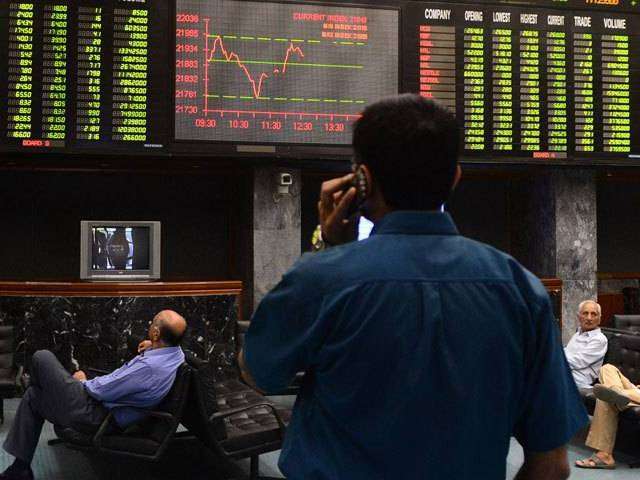
|
Getting your Trinity Audio player ready...
|
Introduction
The Pakistan Stock Exchange (PSX) witnessed a significant dip on Monday as it lost over 1,500 points, driven largely by a broader global market decline and domestic uncertainties. A combination of international trade concerns, particularly following U.S. President Donald Trump’s tariff announcements for Mexico, Canada, and China, alongside local issues like political instability and the looming International Monetary Fund (IMF) review, created a volatile environment for investors.
This article explores the events leading to the PSX’s sharp decline, the impact of global market trends, and the domestic factors that compounded the bearish sentiment. Additionally, we will examine key sectors that contributed to the fall and provide insights into the future outlook for the Pakistani stock market.
Global Market Influence on PSX
U.S. Tariff Announcements: A Catalyst for Global Market Decline
The global market’s downturn began with U.S. President Donald Trump’s announcement of sweeping tariffs on goods from key trading partners, including Mexico, Canada, and China. This decision, signaling the potential onset of a trade war, sent shockwaves through global equity markets, creating a ripple effect that reached the local market.
On the international front, investors reacted swiftly to the news, triggering a widespread sell-off across stock exchanges worldwide. As global markets struggled to find footing, Pakistan’s PSX mirrored this trend, opening under pressure and continuing to fall throughout the day.
Bearish Sentiment at PSX
At the start of the trading session, the KSE-100 index, which represents the top 100 companies in Pakistan, quickly dropped. Despite a brief intra-day recovery that saw the index rise to a high of 114,621 points, the upward momentum was not sustained. The index ultimately closed at 112,745.01, reflecting a decline of 1,510.72 points, or 1.32%.
Factors Contributing to the Market Decline:
- Global Tariff Concerns: The news of U.S. tariffs on major trading partners triggered widespread fear among investors globally. This led to a decline in global equity markets, which was mirrored by the PSX.
- Political Uncertainty in Pakistan: On the domestic front, political instability added further pressure on the market. With elections approaching, uncertainty about governance and policy continuity raised concerns among investors, contributing to the bearish outlook.
- IMF Review and Economic Outlook: The upcoming IMF review and Pakistan’s ongoing economic challenges also weighed heavily on investor sentiment. The IMF’s stance on Pakistan’s fiscal health could influence foreign investment and economic policy, increasing market volatility.
- Rupee Instability: The continued depreciation of the Pakistani rupee further eroded investor confidence. The currency instability raised concerns about inflation and the overall economic health of the country.
Sector-Specific Impact
Fertilizer Sector
The fertilizer sector, a key component of Pakistan’s economy, was hit hard by the market downturn. Companies like Fauji Fertilizer Company saw a significant drop in their stock prices, contributing heavily to the overall decline in the index. With global market instability, concerns over fertilizer exports and domestic consumption patterns weighed on investors’ minds.
Exploration & Production (E&P) Sector
The E&P sector also faced notable selling pressure. The price of crude oil, which directly affects the profitability of exploration and production companies, saw fluctuations due to global market conditions. As a result, companies in this sector, including Mari Petroleum, faced substantial declines in stock value.
Technology Sector
The technology sector, often considered a growth driver in the PSX, was not immune to the global market turmoil. Major tech stocks, including Systems Limited, experienced notable losses. The volatility in tech stocks is a reflection of broader concerns over global trade policies and investor risk appetite.
Domestic Economic Factors
Inflation and CPI Data
Pakistan’s inflation rate for January stood at a low 2.41%, marking the lowest in 111 months. This figure was seen as a positive sign for the economy, as it was lower than the previous month’s 4.1%. However, despite this favorable inflation data, the market remained cautious. Investors were wary of the potential for rising inflation in the coming months, especially if the IMF recommended tightening fiscal policies.
Monetary Policy and Future Expectations
The State Bank of Pakistan (SBP) remained a central focus for investors, as expectations regarding future monetary policy decisions remained uncertain. While inflation was relatively low, concerns persisted about the SBP’s stance on interest rates and the potential for further tightening in the face of global and domestic economic challenges.
Market Performance and Trading Volumes
The overall market activity on Monday reflected the bearish sentiment, with trading volumes decreasing significantly. A total of 401.5 million shares were traded, a noticeable drop from Friday’s 543.1 million shares. Of the 450 companies traded, 137 closed higher, 262 fell, and 51 remained unchanged.
Leading Stocks and Market Movers
Despite the overall market decline, some stocks managed to make gains. Notable gainers included UBL (+0.93%), Lucky Cement (+1.58%), and Meezan Bank (+1.23%). These stocks provided some relief in an otherwise dismal market day.
However, the major laggards included Mari Petroleum (-3.93%), Fauji Fertilizer Company (-1.83%), and Systems Limited (-3.01%). These companies contributed to the overall loss in the KSE-100 index.
Foreign Investment Outflow
Foreign investors were also seen pulling back from the market, with net sales amounting to Rs436.2 million, as reported by the National Clearing Company of Pakistan Limited (NCCPL). The outflow of foreign investment further reflected the global economic uncertainties and concerns about Pakistan’s economic stability.
The Road Ahead for PSX
Potential for Market Recovery
While the PSX experienced a sharp decline on Monday, it is important to note that market trends are cyclical. The future direction of the market will largely depend on how global trade issues evolve, as well as domestic economic factors such as inflation, political stability, and IMF reviews.
If global trade tensions ease and Pakistan can secure favorable agreements with international financial institutions, the market may find a path to recovery. Additionally, investors will be looking for signs of policy continuity and a stable economic outlook to regain confidence in the stock market.
FAQs
1. What caused the PSX’s significant drop on Monday?
The PSX’s drop was primarily driven by global market declines due to U.S. tariff announcements, political instability in Pakistan, and concerns about the IMF review.
2. How did the fertilizer sector perform during the market decline?
The fertilizer sector, including companies like Fauji Fertilizer Company, experienced significant losses, contributing to the overall market downturn.
3. What impact did the global tariff announcements have on the PSX?
U.S. tariffs on key trading partners triggered global market sell-offs, which were mirrored by the PSX, leading to a steep decline in the KSE-100 index.
4. How did the technology sector react to the market conditions?
The technology sector saw notable losses, with stocks like Systems Limited dropping due to the global economic uncertainties affecting investor confidence.
5. What are the key factors influencing the PSX’s future performance?
The future performance of the PSX will depend on global trade conditions, domestic inflation, political stability, and the outcome of the upcoming IMF review.






